Dive Brief:
-
In a lawsuit filed Monday in bankruptcy court in Delaware, hedge fund Standard General alleges that American Apparel's lenders loaded up the clothing retailer with debt to the tune of $82 million between April and October 2016 ahead of its second bankruptcy in about a year, suggesting that a turnaround was not the lenders' priority, according to court papers obtained by Retail Dive.
-
Standard General, which made an agreement with American Apparel founder and then-CEO Dov Charney in 2014 that gave the hedge fund power to make operational and management changes at that time, names Monarch Master Funding, Coliseum Capital Partners, Blackwell Partners, Goldman Sachs and Pentwater (including PWCM Master Fund and Ocean Master Fund) — the retailer’s lender committee — as plaintiffs.
-
Among the allegations are claims that the other lenders, aware that American Apparel (acquired for $88 million earlier this month by Canadian T-shirt company Gildan during a bankruptcy auction) needed more money to survive and revive, instead starved the retailer of funds. In addition, the suit contends that when American Apparel predictably failed to recover, the lenders headed for the exits.
Dive Insight:
It's apparent from these claims that Standard General doesn’t think that its partners have played fair in the last several months, to the detriment of itself and American Apparel.
Together, the members of the lender committee hold 80% of the debt under their credit agreement and more than 90% of the equity in American Apparel, and they control the retailer’s board, according to the lawsuit. “The Lender Committee members’ investments do not mean, however, that they can act unilaterally and without regard for their commitments – even though that is exactly what they have done,” the suit reads. (Coliseum, Monarch, Pentwater, Goldman Sachs and Blackwell Partners did not immediately respond to requests for comment from Retail Dive. Spokespeople from American Apparel and from Standard General declined to comment.)
American Apparel first filed for bankruptcy in October 2015 and emerged as a private company the following February. That kind of swift second filing is known informally as a “Chapter 22” (i.e., Chapter 11 times two) and often entails a wind-down of operations and debt payoffs rather than an attempt to keep a company as a going concern.
In a typical retail bankruptcy (one like American Apparel's original 2015 filing, for example), a judge considers any debtor protections to be in the service of saving a company and protecting jobs, enabling the retailer to wriggle out of leases for underperforming stores a batch at a time rather than renegotiating each lease, with creditors paid pennies on the dollar. But when a retailer returns to a bankruptcy judge so soon after emerging from such protections, it’s more likely looking to leverage whatever value remains in the pieces that are left, according to Jasmin Yang, an associate attorney at law firm Snell & Wilmer who has helped several clients in various aspects of bankruptcy and restructuring (but who did not comment on this American Apparel lawsuit in particular).
From all appearances, that looks to be what has happened in the scenario at American Apparel, and that Standard General is looking to get a bigger piece of the pie. But its allegations also suggest that American Apparel had little chance to survive in the year between its bankruptcies, especially considering that the retail apparel market is tough on a good day.
American Apparel's downfall has entailed the closure of its stores as well as its manufacturing base in Southern California. Earlier this month, the retailer began laying off some 2,400 workers at its Los Angeles headquarters and its manufacturing facilities. New owner Gildan withdrew its initial intention to purchase some of American Apparel’s manufacturing operations, and the brand's Los Angeles manufacturing will cease as a result. Gildan had also declined to buy its retail operations.
Notably, the lawsuit challenges American Apparel's efforts to keep its L.A. factory open, saying that it was sustaining “staggering weekly losses” over Standard General’s objections. The suit also alleges that the retailer had interest from potential bidders to license its intellectual property well before its second bankruptcy filing last November.
Standard General's shot across the bow further complicates an already complex end to an apparel company that for years captured the ardor of young fashionable consumers attracted to its retro vibe and saucy marketing. But, like other apparel companies that have recently stumbled, American Apparel struggled to maintain momentum as young Americans tired of its provocateur approach and opted for cheaper clothing from fast fashion outlets that, while of lower quality, is also consistently on trend.














